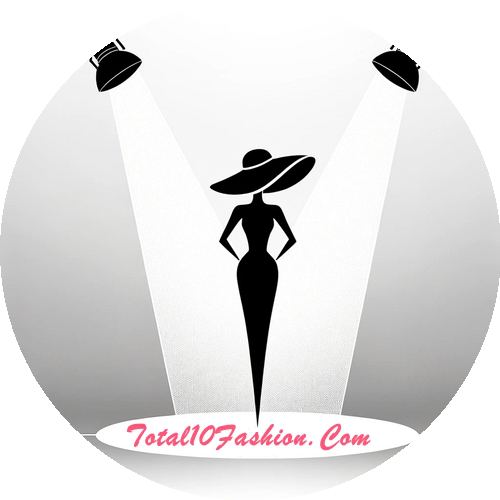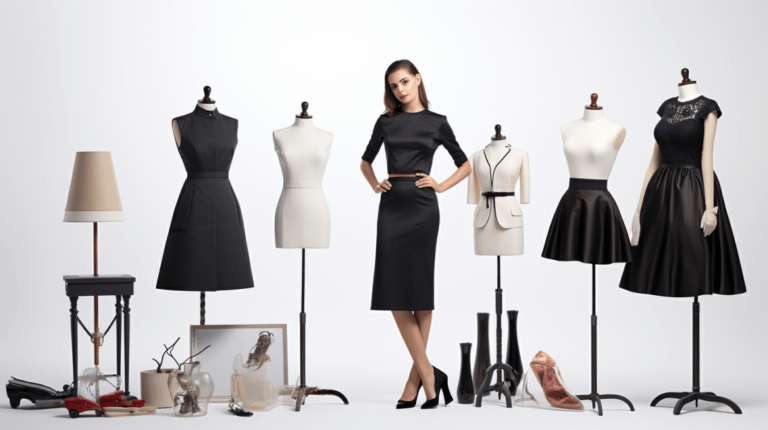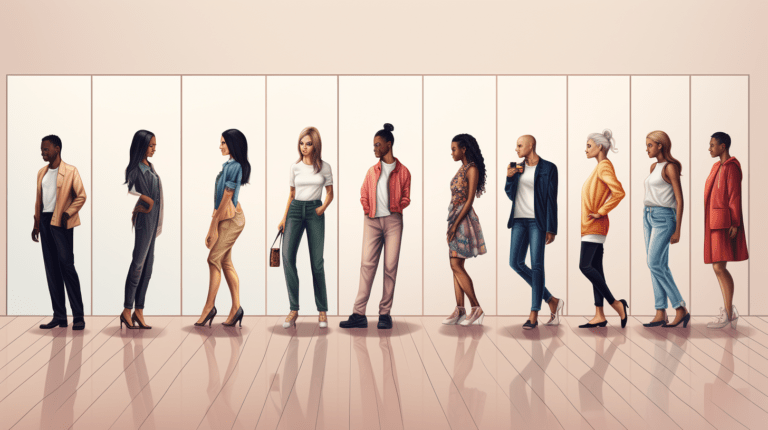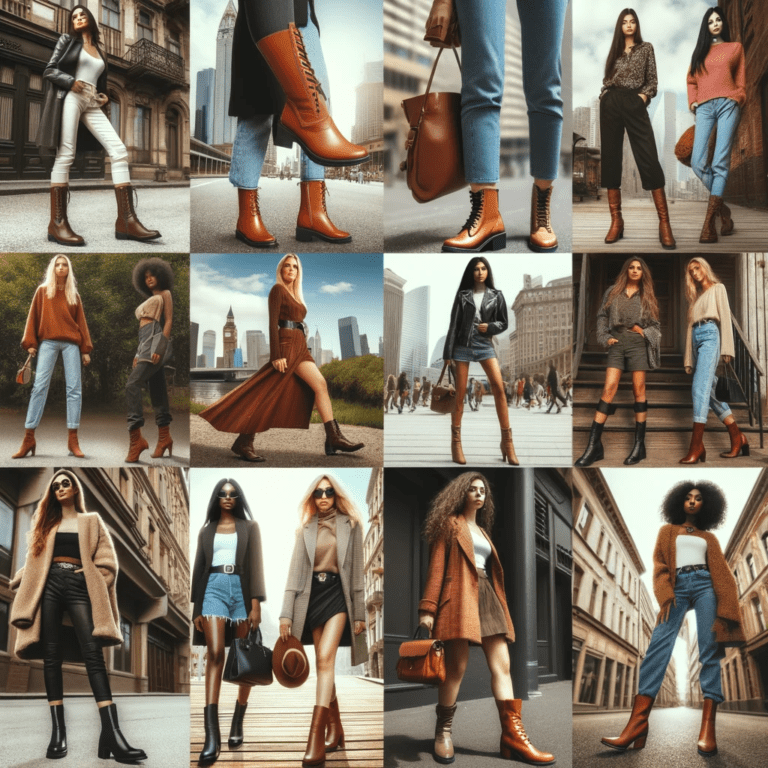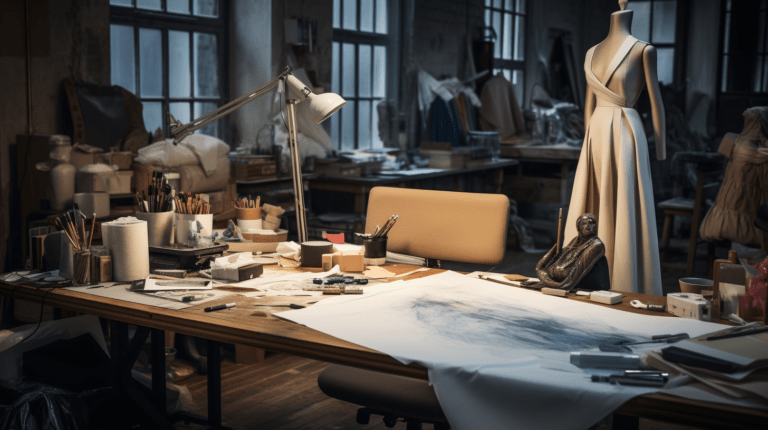How To Become A Fashion Designer – In the world of glamour and grit, fashion design sits at a captivating crossroads. You see, it’s not just about sketching pretty dresses or choosing trendy color palettes. It’s about understanding an industry that evolves with every heartbeat, creating statements that speak without words.
To be a successful fashion designer, you’ll need more than just raw talent and passion; you’ll need knowledge, skills honed to perfection, real-world experience – a fusion of art and commerce.
This article will guide you on your path to becoming a true maestro in the world of fashion design. We’ll explore education requirements, skill development techniques, portfolio creation strategies, gaining practical experience, launching your career and staying current in this dynamic field.
So get ready to unleash your creativity as we unravel the intricacies of turning your dream into reality: becoming a bona fide fashion designer who wields power one stitch at a time.
How To Become A Fashion Designer: Key Takeaways
- Fashion design requires a combination of knowledge, skills, talent, and passion.
- Building a captivating portfolio that showcases a range of designs and reflects skill, creativity, and originality is essential.
- Gaining real-world experience through internships and working in the fashion industry helps in applying skills and learning from industry professionals.
- Staying current in the dynamic field of fashion design, staying ahead of trends, and continuously innovating are important for success.
Understand the Fashion Industry
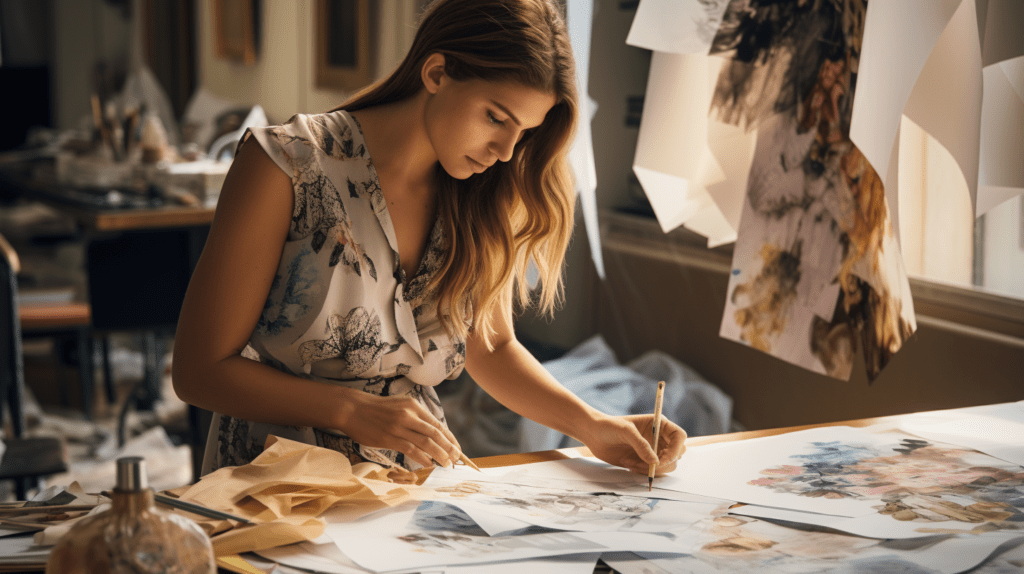
Before you can strut your stuff as a fashion designer, you’ll need to dig deep and truly understand the ins and outs of the ever-changing, fiercely competitive fashion industry. It’s not all glitz and glamour; it requires grit, resilience, and a keen eye for detail. You must be ready to face Industry Challenges.
These challenges range from understanding what drives trends to knowing how to navigate fluctuating consumer demands. The business side of fashion is equally crucial. Grasping concepts like supply chain management, cost control, and marketing strategies will give you an edge in this cut-throat industry. To rise above the competition, it’s essential that you’re familiar with fabric sourcing techniques or how to co-ordinate with manufacturers – these are details that can make or break your success.
An important aspect that should not be overlooked is Sustainable Fashion. The modern-day consumer is becoming more environmentally conscious than ever before. They want clothes that look good on them without harming our planet. This means designers must consider factors like material sustainability, ethical production methods, and waste reduction when creating their designs.
Remember – knowledge is power in this game of threads! Your understanding of the fashion industry will help shape your creative vision into something concrete and commercially viable.
Now that we’ve established the importance of comprehending the intricate workings of the industry, let’s move forward by looking at ways on how one could enhance their skills through obtaining a solid education in fashion design.
Obtain a Fashion Education
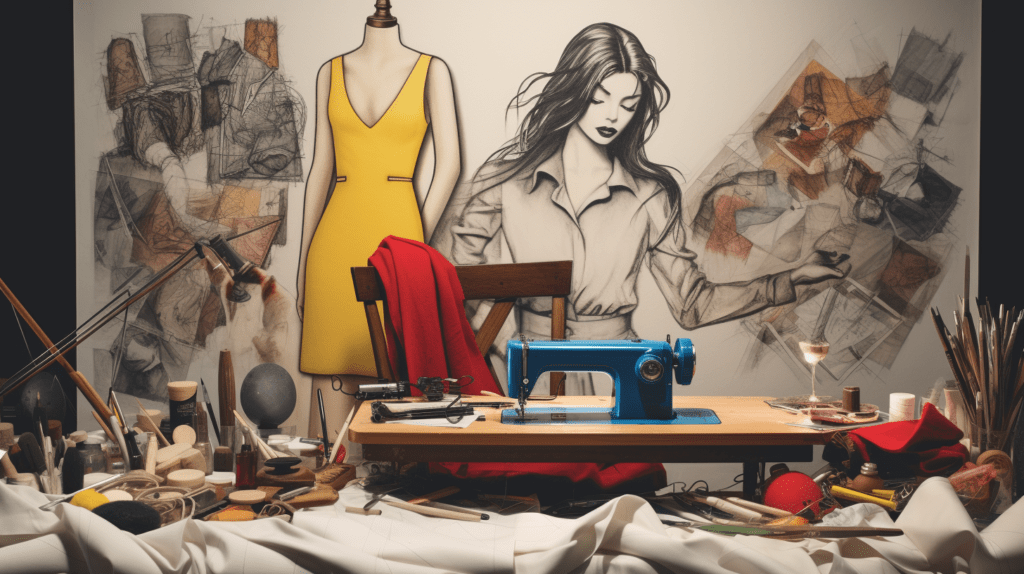
Diving into an education in couture is like unlocking a treasure chest of creativity and innovation—it’s absolutely imperative to master the art of style. You’re not just learning about fabrics and sewing, but also about Fashion History. This informs your understanding of how fashion has evolved over centuries, giving you a rich context for your own designs.
You’ll delve deep into various Designing Techniques too—from sketching to pattern making, draping to tailoring.
When it comes to Fashion History, you need to be familiar with both the great design houses and the game-changing designers who have left their mark on the industry. The powerhouses like Chanel or Dior; iconic figures such as Yves Saint Laurent or Vivienne Westwood; they all brought something new to the table that revolutionized fashion as we know it. Being aware of these historical events gives you a clearer path on where you want to take your own designs.
Designing Techniques are another essential part of your education. Mastering skills such as sketching, pattern making, draping, and tailoring will help transform your vision into reality. It’s not enough just having imaginative ideas; being able to execute them flawlessly is what separates successful designers from dreamers.
As you dive deeper into study, never underestimate its value nor lose sight of why you began this journey in the first place: to create beautiful pieces that empower those who wear them.
Next up? It’s time for action—focusing on honing those practical skills that make true designers stand out from mere enthusiasts.
Develop Your Skills
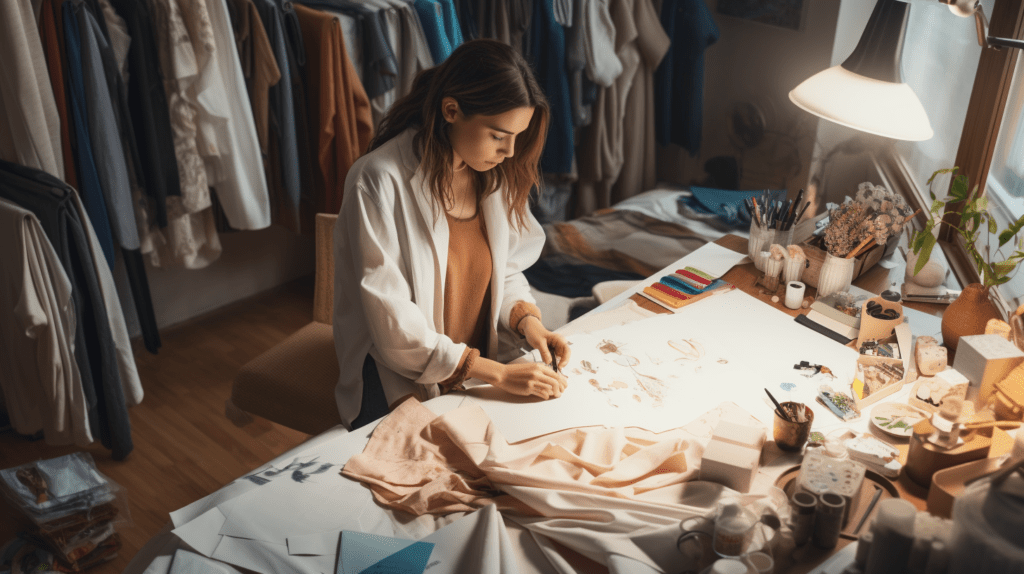
Now’s your chance to really shine by refining and perfecting your skills. Remember, being a successful fashion designer isn’t just about having great ideas – it’s also about executing them skillfully. So now you need to focus on honing your drawing techniques and making appropriate fabric selections.
Let’s look at three key areas where you can level up: Drawing Techniques, Fabric Selection, and Attention to Detail. Each of these columns represents an area that requires constant practice and improvement.
| Drawing Techniques | Fabric Selection | Attention to Detail |
|---|---|---|
| Improve sketching ability | Understand different materials | Notice small changes in design |
| Master usage of color & shade | Learn how fabrics behave & combine | Perfect the finishing touches |
| Translate 3D designs into 2D sketches | Keep up with textile trends & innovations | Develop a keen eye for proportions |
| Experiment with digital design tools | Build relationships with suppliers | Cultivate patience for intricate work |
| Practice drawing different body types & clothing styles | Develop intuition for what works best in a design | Always strive for perfection |
You will find that as you develop these skills, you’re not only becoming more proficient but also gaining the power and confidence necessary to stand out in this highly competitive field.
Remember not to rush this process. It takes time, effort, dedication, but it’s all worth it when you see your designs come alive exactly as envisioned.
The next phase of your journey is creating a captivating portfolio – an essential tool showcasing your unique style and demonstrating your mastery over design elements. This will be an opportunity for potential employers or clients to witness firsthand the fruits of all the hard work put into developing your skills.
Create a Portfolio
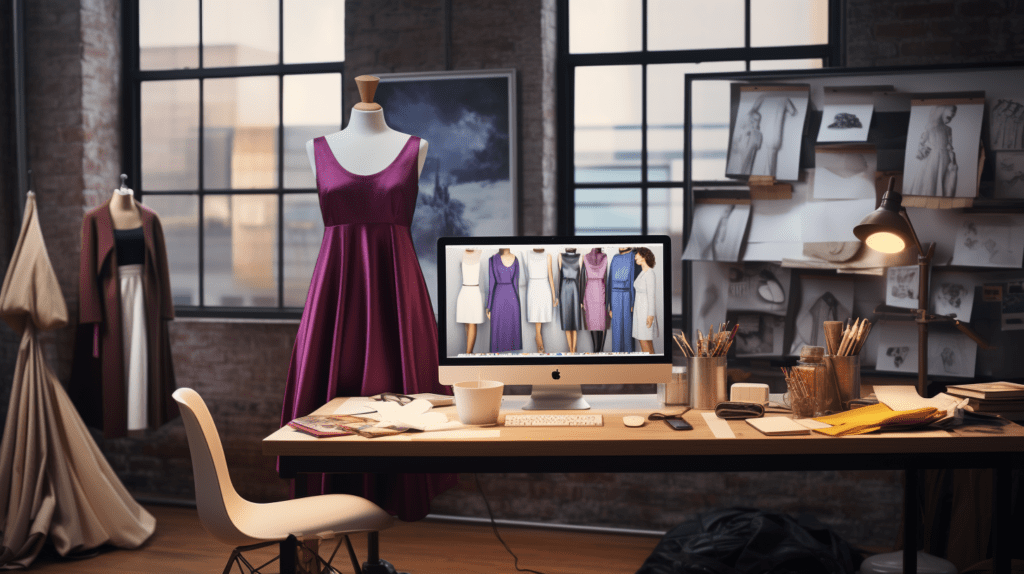
It’s high time to gather up your masterpieces and start piecing together a stunning portfolio that’ll knock everyone’s socks off. The power of your fashion designing career lies in the strength of your Portfolio Presentation. It’s not just about showcasing what you’ve designed but how you present it.
Your portfolio is your key to unlock doors in the fashion world; therefore, it must speak volumes about your skill, creativity, and originality.
Consider Portfolio Diversification as an important aspect when creating your compilation. Don’t restrict yourself to one particular style or genre. Showcase a range of designs – from streetwear to couture, from minimalist aesthetics to maximalist grandeur. Show them that you can dominate any fashion battlefield with confidence and prowess.
Remember, quality trumps quantity every time in this game of power. Include only those pieces that reflect your best work. Do not hesitate to exclude designs that don’t meet the bar you’ve set for yourself – this isn’t about filling pages, but about making each page count.
Your portfolio should tell a story – your story as a designer – through visuals and narratives covering the concept development process, mood boards, fabric swatches, sketches, photos of finished garments on models or mannequins, and feedback received if any.
Now let’s talk presentation: Opt for professional-grade materials for binding and printing; they denote seriousness with which you take your craft. And digital portfolios? They’re equally significant in our tech-driven era so make sure yours is easy-to-navigate yet visually compelling.
Time spent perfecting this tool of persuasion will pave the way for opportunities where you can apply these skills practically — getting real-world experience under some prestigious labels perhaps?
Get Real-World Experience
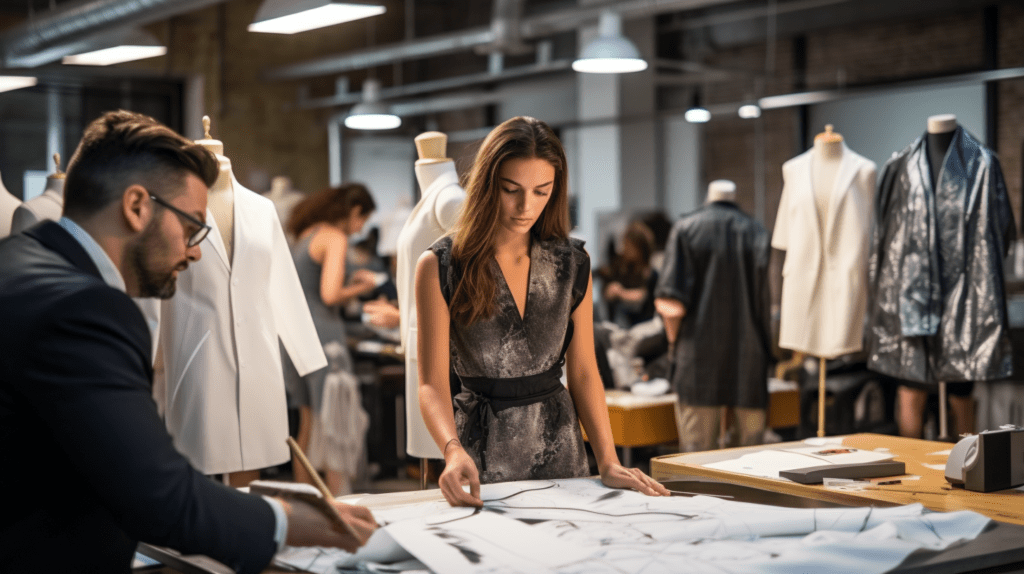
Now that you’ve built a portfolio showcasing your unique style and vision, it’s time to step up your game by getting tangible experience in the fashion industry.
Consider landing an internship with a renowned fashion house where you’ll gain invaluable knowledge on the inner workings of the industry.
Alternatively, working in retail or another fashion-related job could offer you real insights into consumer trends and demands, effectively honing your ability to predict what will sell in future seasons.
Internships in fashion design
Landing an internship in fashion design can feel like striking gold, offering a priceless opportunity to immerse oneself in the vibrant world of haute couture. These internships offer invaluable benefits, giving you a firsthand look at the inner workings of the industry. You’ll learn to navigate its intricate systems and grasp the art and science behind creating trendsetting pieces.
Don’t shy away from unpaid internships either; they may not fill your pockets, but they will certainly enrich your knowledge and experience. You’d be rubbing shoulders with key industry players, understanding their processes while also refining your own creative abilities.
Remember though, it’s not just about designing; it’s also about selling those designs. So after this invaluable immersive experience as an intern, consider honing these skills further by taking on roles in retail or other fashion-related jobs.
Working in retail or fashion-related job
After soaking up all that knowledge and experience from your internship, you’re perfectly positioned to dive into the retail world or nab another job related to style and trends. Working in this sector provides a platform for retail networking and learning customer insights.
Consider this table that outlines three critical experiences you’ll gain:
| Experience | Benefits | How it Boosts Your Fashion Career |
|---|---|---|
| Retail Networking | Building connections with key industry players | Expands opportunities for collaborations |
| Customer Insights | Understanding client needs & preferences | Helps design clothes that sell |
| Real-world Exposure | Learning about latest fashion trends & market demands | Keeps your designs relevant & competitive |
Leveraging these experiences effectively will give you an edge as you prepare to launch your fashion career. Now’s the time to really let your creativity shine through in the cutthroat world of fashion design!
Launch Your Fashion Career
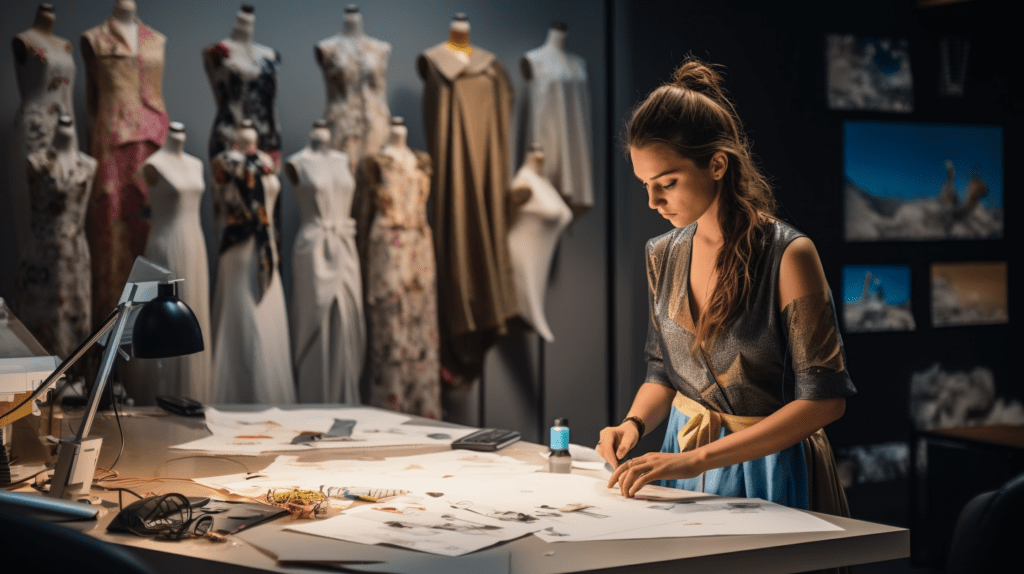
Bursting onto the fashion scene, your unique designs will shimmer under the spotlight as you begin to launch your career in this vibrant industry. It’s an exhilarating journey that requires more than just talent and passion. You need a strategic plan, sharp business acumen, and the ability to seize networking opportunities when they arise.
To ensure that you’re poised for success, here are some crucial steps:
- Exploit Networking Opportunities:
- Attend fashion shows, conventions, trade fairs to interact with like-minded individuals.
- Build connections through social media platforms.
- Seek mentorship from seasoned professionals in your field. They can offer invaluable insights and guidance.
- Conceptualize Your Brand:
- Define what makes your design stand out; it could be intricate detailing or innovative silhouettes.
- Develop a compelling brand story that resonates with your target audience.
- Devise Funding Strategies:
- Consider bootstrapping initially if possible.
- Explore crowdfunding platforms or find investors who believe in your vision.
Remember, every decision you make should reinforce the strength of your brand. It’s not just about creating beautiful clothes; it’s about creating a powerful movement that people want to be part of.
As you continue on this path towards becoming a fashion designer extraordinaire, never lose sight of why you started this journey in the first place. Let that drive fuel your ambition as you navigate challenges and overcome obstacles.
The next phase awaits where you’ll learn how crucial it is to stay ahead of trends while innovating continuously. This constant evolution is vital for any fashion designer aiming at long-lasting relevance and growth.
Stay Current and Innovate
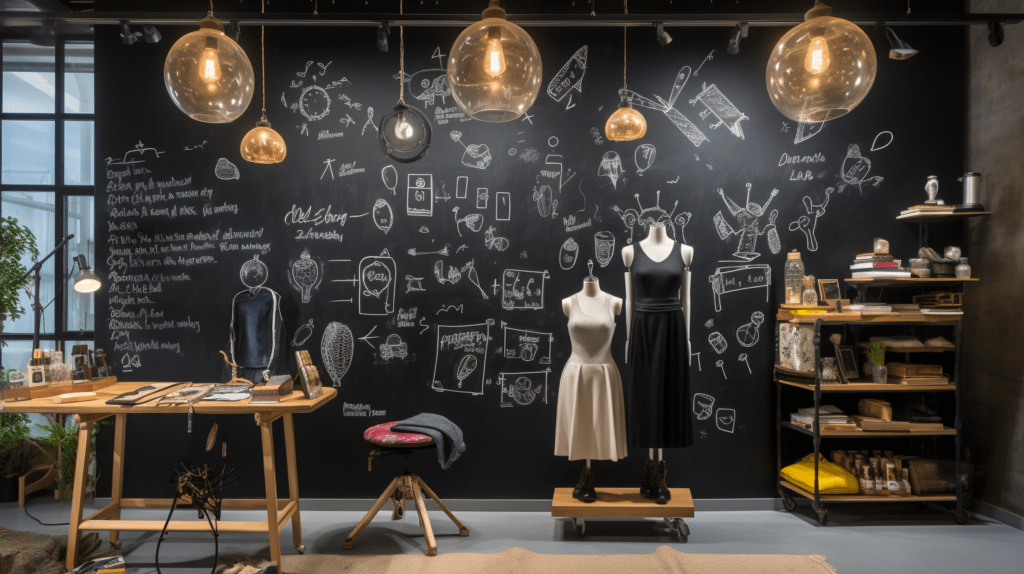
In the vogue world, your growth never ceases. It’s essential to keep up with the latest trends and fashion news because they’re your lifeblood, pulsing through the veins of your design work.
Not just that, but investing in continuing education and professional development is also equally important—it allows you to innovate constantly, bringing fresh perspectives and novel ideas to the runway.
Continuing education and professional development
You’ll need to keep up with the latest trends and constantly educate yourself, as the world of fashion is always evolving. That’s where continuous learning benefits come into play. They not only equip you with new skills but also give you an edge in this competitive field.
Consider enrolling in online courses or attending industry workshops to broaden your knowledge base and sharpen your creativity.
Furthermore, participating in mentorship programs can open doors for you. Experienced fashion designers can provide valuable insights that textbooks don’t offer, helping you navigate through challenges with more confidence and finesse.
Remember, power lies in knowledge and growth is fueled by constant learning.
Now it’s time we delve deeper into how staying abreast with current trends and fashion news can further boost your success journey.
Keeping up with trends and fashion news
Staying on top of the latest trends and news in the style world is essential to your success. You must develop a keen eye for what’s hot, what’s not, and what’s next.
Social Media Influence is critical here; platforms like Instagram and Pinterest can be treasure troves of inspiration. Follow influential fashion bloggers, designers, and stylists who are trendsetters in their own right. Their posts provide an insight into current fads and future directions in fashion.
Celebrity Style Analysis can also be insightful. Celebrities often sport trends before they hit mass market; analyzing their outfits may give you a glimpse into upcoming styles.
Remember, creativity fueled by knowledge is power in this industry. So stay informed, stay inspired, and keep designing with passion and precision.
Frequently Asked Questions
What is the average salary of a fashion designer in the United States?
You’re curious about the average salary of a fashion designer in the U.S, right?
Well, it varies greatly due to Designer Wage Disparity. On average, you could expect around $73,790 annually.
However, remember that this is just an average figure and with effective Salary Negotiation Strategies, your earnings might significantly increase.
Your creativity and experience can command higher pay. Thus, don’t settle for less- harness your skills and negotiate like a pro to get what you deserve!
How can I network effectively in the fashion industry?
Start by attending industry events. They’re a goldmine for networking in the fashion world, offering opportunities to mingle with designers, buyers, and influencers.
Be bold; introduce yourself and state your ambitions clearly. Seek mentorship opportunities too – connecting with experienced professionals can catapult your career forward.
Remember, in this industry, who you know is as crucial as what you know. Craft a compelling personal brand that commands respect and showcases your creativity – it’s your ticket to power in the fashion world.
How to balance my personal life and high-pressure fashion career?
Balancing a high-pressure fashion career and personal life requires mastery of time management strategies.
Prioritize tasks, delegate when possible, and schedule downtime as you would meetings.
Cultivate stress coping techniques like regular exercise, mindful meditation, and nutritious meals to combat pressure.
Remember, your power lies in your ability to manage both effectively without sacrificing one for the other.
Stay focused on your goals while nurturing relationships that matter to you personally.
Balance is attainable; it requires strategy and commitment.
Are there any health benefits or insurance typically provided for fashion designers?
Indeed, as a fashion designer, safeguarding your mental wellness is crucial to prevent ‘Designer Burnout’. Many fashion companies recognize this and often provide health benefits, including mental health support. They may also offer insurance policies covering medical expenses.
These benefits are not just for physical wellbeing, but to empower you in maintaining optimal creativity and productivity. Remember, you’re at your most powerful when balanced–and the industry is increasingly recognizing that.
What are some common mistakes beginners make in the fashion industry and how can I avoid them?
Surprisingly, 80% of fashion startups fail within the first five years. Navigating designing pitfalls is crucial to thriving in this industry.
Overdesigning is a common mistake. A designer’s zeal can lead to overcomplicated styles that confuse consumers. Resist the temptation to put all your ideas into one piece; simplicity often sells better. Be deliberate with your designs, knowing when and where to draw the line will demonstrate power and control over your creative process.
Conclusion
In wrapping up, remember that Rome wasn’t built in a day. You’ve got to learn the ropes, hone your craft, and get your hands dirty in the fashion world. Keep pushing boundaries and stay current. With patience and perseverance, you’ll make it big as a fashion designer.
So go on, start sketching your path to success today!
